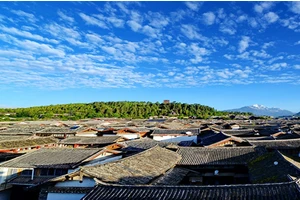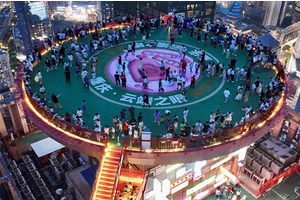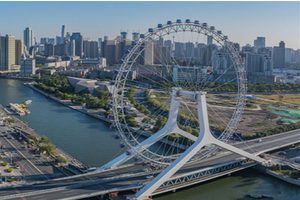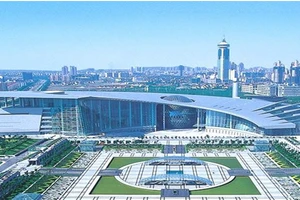Travel near Peking University
Tourist attractions in Peking University
There are many bronze statues of the unnamed lake, the island in the middle of the lake, the stone boat, the Peking University Yanyuan Stone Boat Site, the Red Chamber of Peking University, the Zhong Pavilion and Cai Yuanpei. Just go and see for yourself. The following is a detailed introduction:
Weiming Lake is the largest artificial lake in Peking University campus, located in the north-central part.
The shape is u-shaped. There is a stone fish sculpture in Hunan, and there is an island in the middle of the lake, which is connected with the north bank by a bridge. There is a stone boat at the southern end of the island in the middle of the lake. There are Bell Pavilion, Linhuxuan, Flower Temple and edgar snow on the bank of Hunan, and Boya Tower on the east bank.
The lake used to rely on Wanquan River for water supply, but now it relies on artificial water storage. Ice skating rink in winter.
In Qing Dynasty, it was an artificial lake in Shuchun Garden, He Shen Garden attached to Yuanmingyuan. The stone boat was built according to the stone boat in the Summer Palace, but later the superstructure was burned down, leaving only a stone base.
In the 1920s, it became a part of yenching university, and the school asked the designer henry killam murphy to plan the campus layout. The lake was named the unnamed lake by Qian Mu. In 2001, the "Unnamed Lake Yanyuan Building" near the lake was listed as a national key cultural relics protection unit.
People enter from the west gate of Peking University guarded by the stone lion, and not far away, they can see a pair of beautiful Chinese watches standing in the semi-open space surrounded by the office building and the temple. Continue to stroll eastward, no matter which way you enter the garden space with the unnamed lake as the main body, you will feel suddenly enlightened. In the whole Yan Garden, the unnamed lake is more like a vast ocean. Under the action of light, the lake seems to be moored with thousands of stars, giving off ever-changing light. On the unnamed lake, the tower shadow of the lake can be seen in the east; West can see the sunset in the bell pavilion; In the south, there are mountains and lakes; The shadows of the buildings in the north are full of poetry and painting. Therefore, some people summarized the essence of Yan Garden as "a picture of a tower and a lake".
the lake
The island in the middle of the lake is one of the relics of Shuchun Garden in He Shen. The scene of the luxurious buildings built by He Shen in imitation of the "Pengtai Fairy Island" in Yuanmingyuan was later destroyed by the British and French allied forces.
Island pavilion
Island Pavilion is located on an island in the center of Weiming Lake. The octagonal square pavilion makes people feel "yet we called and urged a thousand times before she started toward us". This square pavilion is the island pavilion. The whole pavilion is made of wood, and eight red wooden columns support the double-eaves tile and pagoda-shaped pavilion top. There are vivid paintings on the wooden beams of the pavilion, some of which are figures and historical stories, and some are landscapes, which are completely in line with the traditional architectural features of China. The base of the pavilion is an octagonal stone platform about one meter high.
Peking University Yanyuan Stone Boat Site:
Located on the unnamed lakeside of Peking University Yanyuan, this area was called Shuchun Garden in Qing Dynasty, which was a part of Yuanmingyuan and was given to He Shen by Qianlong. In the tenth year of Xianfeng, the British and French allied forces burned the Yuanmingyuan, and Shuchun Garden was also destroyed. Only the stone boat base and the "facing the wind and waiting for the moon building" remained, which is now the Linhu Pavilion.
Peking university honglou
The Red Mansion in Peking University is a building with an extraordinary history in Beijing, which is named after its main body is made of red bricks. Since the Red Mansion was completed 83 years ago, it has become the source of China's advanced ideas and culture.
The red building, the starting point of red. After the baptism of the New Culture Movement and the May 4th Movement in China, a large number of people with lofty ideals understood and accepted Marxism.
The Red Chamber is the starting point of the revolution. The pioneers of communist party, as representatives of advanced social culture, left a glorious footprint here in those years. Since then, the history of China has turned a new page.
A page in the history of Peking University Red Mansion
Beijing is an ancient historical and cultural city, but also a city with a glorious revolutionary tradition. In the arduous battle course of the Communist Party of China (CPC), countless martyrs shed deep red blood on the hot land of the ancient capital, and wrote their pride for the city with clank and loyalty.
Eighty-three years ago, in the northeast corner of the Forbidden City in Beijing, a long I-shaped building with four floors above ground and one floor underground stood. It sits north to south, and its western style was called the most modern building in Beijing at that time.
But the most visual impact of this building lies in its color. The Red Chamber is truly red, and the whole building is made of red bricks, so it has been called the Red Chamber since its completion. Under the sunlight, this building is full of vigor and hope.
The original builders certainly didn't realize that from then on, red became the main theme of China history, and groups of people with lofty ideals went out from here and devoted themselves to the fiery revolutionary journey.
As time goes by, this red building, which witnessed many important events in the history of China, has also experienced many vicissitudes. Weathered by the wind and rain, many parts of the building can clearly see the traces of being repaired with blue bricks, but she stands upright, the red theme has not changed, and the name of the Red Chamber is still being called.
The current address of the Red Mansion is No.29, May 4th Street, Beijing. From the name alone, we can know that it is a street with many glories, and naming a street after a historical event is probably unique among many road names in Beijing. On the wall on the right side of the gate of the Red Mansion, there is a marble inlaid with instructions inscribed by the Beijing Student Union and the Peking University Student Union: The Red Mansion is a part of the former site of Peking University and one of the important activity places of the May 4th Movement. Comrade Li Dazhao and Mao Zedong used to work here. Behind the Red Mansion is the "Democratic Square" named by the North China Federation of Students in 1947.
As a part of the former site, speaking of the Red Mansion, it is natural to briefly review Peking University nearly a century ago. Peking University is located in Zhongguancun, the northwest corner of Beijing. The Red Mansion was built in 1918.
If it is only an old red brick building, it is unlikely that the Red Mansion in Peking University will become the first batch of national key cultural relics protection units on March 4, 1961. This honor comes from the fact that the Red Mansion in Peking University is of great significance in the New Culture Movement in China and the history of communist party. It is the birthplace of the May 4th Movement.
Brilliant footprint red starting point
Mao Zedong once pointed out clearly: "To study the history of the Communist Party of China (CPC), we should also study the materials of the Revolution of 1911 and the May 4th Movement before the founding of the Party. Otherwise, we cannot understand the development of history. "
In 1915, Chen Duxiu, one of the founders of the Communist Party of China (CPC), founded Youth magazine (later renamed New Youth) in Shanghai. He held up the two banners of "democracy" and "science", lashed out at the old feudal culture and advocated a new culture, from which the new cultural movement started and became a prelude to the arrival of a new revolutionary storm.
In January, 1917, Cai Yuanpei became the president of Peking University. He advocated academic inclusion, and immediately hired Chen Duxiu as a liberal arts senior. At the end of the year, Li Dazhao went to Peking University as the director of the library.
The victory of the Russian October socialist revolution in 1917 had a great influence on the people of China. Marxism began to spread in China, and the advanced elements in China began to use the proletarian world view as a tool to observe the destiny of the country.
Zhang Shenfu, who was one of the 14 members of the Beijing Communist Group when it was founded, recalled: "In the summer of 1918, the Red Mansion on the beach was built and the library moved in, occupying the first floor of the Red Mansion. Li Dazhao's director's office is located in two houses in the southeast corner of the Red Chamber. For a time, the Red Chamber became the center of the new ideological movement, and many progressive teachers and students gathered here to study and discuss. " "After Li Dazhao took office, he made some major adjustments and reforms to the library's business, and began to pay attention to collecting books on Marxist theory and works since the October Revolution in Russia."
This is Li Dazhao's office in the southeast corner of the first floor of the Red Building. Room number is 119. Shortly after moving into the Red Chamber, Li Dazhao published articles such as "The Victory of the Common People" in November 1918, which represented the new awakening of the advanced elements in China. In May of the following year, Li Dazhao edited the Special Issue of Marxist Studies for New Youth, and personally wrote My View on Marxism, which systematically introduced the basic viewpoints of the three components of Marxism-political economy, scientific socialism and historical materialism. This is the first systematic and complete introduction to Marxism in China's works.
In this ordinary office of the Red Chamber, Li Dazhao presided over the establishment of the first communist group in the north-the Beijing Communist Group. He also convened a meeting of members of the young chinese Society here, and the Red Chamber of Peking University became an important place for early Marxist activities in Beijing. Zhang Shenfu recalled: "Under the leadership of Li Dazhao, the library became a center for studying and spreading Marxism in Peking University. Many radical students often went to the library to discuss various new thoughts with Dazhao and listen to him introduce new ideas. Everyone often meets here to discuss the way out of China and seek ways to save the country and the people. "
In August, 1918, a handsome young man came to Beijing, and then walked into the Red Chamber. He was the great man Mao Zedong from Hunan, who later changed the fate of China and led the revolution to victory. This is Mao Zedong's first visit to Beijing. At that time, he and Li Weihan and other 24 people came to Beijing to organize Hunan youth to work and study in France. Afterwards, Mao Zedong stayed in Beijing. After being introduced, he got to know Li Dazhao, worked as an assistant in the library, and began to study Marxist theory. Mao Zedong also began to specifically understand the October Revolution and Marxism, and embarked on the road of communism.
The May 4th Movement, which broke out on May 4th, 1919, became the beginning of China's new-democratic revolution. The May 4th Movement promoted the integration of Marxism with the workers' movement in China, and the China Revolution entered a new historical period. Mao Zedong once pointed out brilliantly in "On New Democracy": "The May 4th Movement prepared for the establishment of the Communist Party of China (CPC) in 1921 ideologically and cadres."
Zhongting
Zhong Ting is located on the small earth mountain on the west bank of Weiming Lake. It faces the lake in the north and is facing the fish that Peking University people are very familiar with. At the foot of the mound mountain in the south is the Qianlong poem tablet, and not far from the west is the statue of Cai Yuanpei. There is a path between the statue of Cai Yuanpei and the Qianlong poem tablet, which leads to the lake.
The Bell Pavilion was built in September, 1929. The origin of the bell has been impossible to verify, and it is used as the school clock in yenching university. The words on the clock are clear and impressive, and you can make a heavy and powerful sound by tapping with your hand. The school clock has its own way of ringing the bell, and different ways have different meanings. )
People who come to Yanyuan will not miss the Bell Pavilion, a small hexagonal pavilion located on the small earth hill on the west bank of Weiming Lake. The reason why we can't miss it is because Xiaotushan has an excellent location, facing the lake in the north and facing the fish that Peking University people are very familiar with. At the foot of the mound mountain in the south is the Qianlong poem tablet, and not far from the west is the statue of Cai Yuanpei. There is a path between the statue of Cai Yuanpei and the Qianlong poem tablet, which leads to the lake. I'm afraid that the people who built the bell pavilion were worried that we would bypass the humble small earth mountain and ignore the exquisite and beautiful bell pavilion, so three winding paths were opened in the north, west and south, which led directly to the bell pavilion. Each path was made of irregular stones, which made it feel a little more like climbing a mountain than the well-behaved stone steps. Climbing up the stairs, you can see the whole picture of the bell pavilion in just a moment.
Bell pavilion, there are bells and pavilions. Pavilion-dome with six corners and painted on it; Clock-antique, with eight petals of lotus at the bottom, like a skirt worn by girls. The lower part of the bell is carved with the rough sea and the rising sun bursting out from the sea. On the upper part of the clock body are twelve pairs of dragon playing beads that dance and roll. The bell ears hinged by two stout green dragons are hung on a crossbar at the top of the pavilion. In addition, the clock body is engraved with gossip patterns, and there are two words written in Manchu and Chinese: "The year of Bing Shen in the Great Qing Dynasty was eight months". According to this date, it has been more than 100 years since the year of Bing Shen of the Great Qing Dynasty, that is, in 1896. This clock was born earlier than the "Jingshi University Hall"!
According to relevant research, it turns out that the old Peking University used a clock to tell the time. The reason why Zhong Ting has a clock in the pavilion is probably the original idea. In "Old History of Peking University", an old Peking University alumnus described the bell at that time like this: "The bell of the Second Hospital of Peking University was never controlled by a motor button, but a tall, old rotten wooden seat with a dark and heavy iron clock hanging on it, which has a history of at least 70 or 80 years. At that time, when the school was opened, the party concerned did not know where to find it, but it was still knocked by a nearly 70-year-old man with a gray beard and a faded blue cloth jacket, with about 16 to 18 knocks each time. This bell is loud and clear, not only in the Second Hospital of Peking University, but also in the First Hospital, the library, the research institute, the Dongxizhai and other places. Students live in nearby hutongs. They lie in a sunny bed in the morning. When they wake up, they are anxious to wash their faces and rinse their mouths after hearing the bell of class. Therefore, this bell is poetic and picturesque, which is beyond the ordinary electric clock. " At that time, the Zhong Ziran used was not the clock in the Zhong Ting now. Regarding the origin of this bell in the bell pavilion, there is a record in the royal garden of the Summer Palace: "In 1889, Cixi used to be a parade platform to review the Beiyang Navy transferred by Li Hongzhang and the newly graduated Marine Corps students of the Navy Academy. In order to adapt to the exercise, the small fireboat was changed into a gunboat, and artillery teams and cavalry teams were arranged on both sides of the east and west.
At that time, the big bronze bell, which was used by the navy to tell the time, was robbed in 1900, and was later placed in yenching university, which is now in the unnamed lakeside bell pavilion in Peking University. "
If Zhong could talk, it would certainly tell us a lot of past events ... Perhaps, from the time it told for Beiyang Navy until how it escaped from the looting in Eight-Nation Alliance; Perhaps, it has been abandoned for several years, and from where it moved to this lakeside slope; Perhaps, who has rung it again, and how it conscientiously grasps the schedule for generations of students; Perhaps, it still remembers January, 1929, the day when it became the school clock in yenching university. In June, it moved to the bracket of the unnamed lake, and in September, it was accompanied by the dome six-column bell pavilion. Perhaps, it still remembers the "Bell Knocking Law" which was resolved at the meeting of the former yenching university Executive Committee: "The bell shall be rung once every half hour, starting at 12: 30, once twice, once and a half times, three times, ... at four o'clock, eight times, and then it shall be rung again at 4: 30. If it is circulated every four hours, it will be the bell ringing time from 6 am to 11 pm every day. " Perhaps, it still remembers that the number of people who hit the bell has been ten years. With his life and its life, in the stormy years, the hearts of patriotic teachers and students were stirred with loud and deep bells.
Cai Yuanpei bronze statue
Cai Yuanpei (1868-1940), born in Shaoxing, Zhejiang, is a famous educator in China. Cai Yuanpei organized the Guangfu Association in his early years and later joined the League. After the Revolution of 1911, he became the education chief of Nanjing Provisional Government. From 1916 to 1927, he served as president of Peking University, making outstanding contributions to the development of Peking University and the education in China. Comrade Mao Zedong once praised him as "a leading scholar and a model of the world".
Cai Yuanpei's bronze statue was donated to his alma mater by graduates of Grade 77 and Grade 78 in Peking University. It was created by the famous sculptor Professor Ceng Zhushao and cast with the assistance of Beijing Institute of Iron and Steel and Capital Iron and Steel Company.
roll tailed stone fish
Fanwei Stone Fish is a relic of Changchun Garden in Yuanmingyuan. In the northern part of Changchun Garden, there is a harmonious curiosity (built in the twelfth year of Qianlong), and there is a large fountain in front of it. The flip-tailed stone fish is the ornament in this fountain. Yuanmingyuan was burned and looted twice by the British and French allied forces and Eight-Nation Alliance, which made the world famous garden in ruins, lost all the precious cultural relics and sold off the fish. It was bought by Zai Tao, the owner of Longrun Garden. When yenching university graduated from class in 1930, he bought this stone fish and gave it to his alma mater as a souvenir. Since then, the stone fish has settled in the unnamed lake.
lake house
Linhuxuan was originally the residence of yenching university President Si Tuleideng (1916-1962), and part of it was also used as a place for yenching university to receive distinguished guests and hold meetings. Ma Yinchu (1882-1982), former president of Peking University, once lived here. Now it is the VIP reception room in Peking University. "Linhuxuan" was named by Bing Xin, an alumnus and famous writer of Peking University.
The west room of our hospital used to be Lin Maike's bedroom. Lin Maike, a British scholar. In 1937, he was hired as an economics tutor in yenching university, and led the establishment of the Oxford-style tutorial system. Under the control of Japanese imperialism at that time, Lin secretly visited the anti-Japanese guerrilla zones in North China several times and purchased medicinal materials and radio equipment from the Eighth Route Army in occupied Peiping. When the Pearl Harbor incident broke out in 1941, the Lins entered the anti-Japanese base area with the help of the Eighth Route Army, and took part in the anti-Japanese work in Shanxi-Chahar-Hebei and Yan 'an, until Japan surrendered in 1945 and returned to Britain with his wife and children. Lin visited China several times after liberation.
Snow tomb
Snow's tomb is located on the site of the original flower temple. The tombstone is a rectangle of white marble, on which is inscribed the inscription "Tomb of edgar snow, an American friend of the people of China" by Ye Jianying, with English bets. Surrounded by pines and cypresses, the tomb is covered with green grass. Facing a lake with clear water, I feel more quiet and solemn.
Edgar, Si Nuo. (1905-1972) American journalist and writer was born in Kansas City, Missouri, USA, and studied in the journalism department of the University of Missouri.
Si Nuo came to China in 1928 and worked as a reporter and correspondent for several newspapers in Europe and America. From April, 1933 to June, 1935, Si Nuo was also a lecturer in the journalism department of yenching university in Beiping. In June 1936, Si Nuo visited the Shaanxi-Gansu-Ningxia Border Region and wrote a lot of communication reports, becoming the first western journalist to cover the Red Zone. After the outbreak of War of Resistance against Japanese Aggression, he served as a war correspondent in China for the Daily Herald and the American Saturday Evening Post. In 1942, he went to Central Asia and the Soviet Union for an interview and left China. After the founding of New China, he visited China three times and died of illness in Geneva on February 15th, 1972.
Si Nuo is an upright American who loves peace and upholds justice. He is very concerned about the fate of China and enthusiastically supports and protects students' patriotic enthusiasm. In June 1935, Si Nuo was hired as a special correspondent for the British Daily Herald, and soon moved back to No.13 East Armor Factory.
At that time, on the eve of the December 9th Movement, yenching university was an important position for the CPC to lead the student movement. Si Nuo actively participated in the activities of the Journalism Society of Yanda University, and their home was also a place frequented by many patriotic and progressive students. Wang Ruhai (Huang Hua) and Chen Hanbo of yenching university, Yao Keguang (Yao Yilin) of Tsinghua University and Yu Qiwei (Huang Jing) of Peking University were all frequent visitors to his home. Underground party member discussed the specific steps of the "December 9th" movement in Si Nuo's home, and informed the Si Nuo couple of the routes and meeting places of the two parades on December 9th and 16th. On the eve of the March, Mr. and Mrs. Si Nuo translated the Declaration of Students' Self-government Association of No.10 School in Peiping into English overnight, distributed it to foreign journalists in Peiping, and asked them to send telegrams abroad, and contacted many foreign journalists in Peiping to interview at that time.
On the day of the parade, Mr. and Mrs. Si Nuo and other foreign journalists followed the parade, seriously reporting the real situation of students besieging Xizhimen and being blocked by Xuanwu Gate. He sent an exclusive newsletter to The Sun in new york, where he left a lot of written materials and photos about the "December 9th" movement. Si Nuo also suggested that the Yan University Students' Autonomy Association hold a foreign press conference, and the students once again showed the great significance of the December 9th Movement to the west.
After the fall of Peiping, Si Nuo sheltered many progressive students in his own residence and helped them to leave the dead city of Peiping, join the anti-Japanese guerrillas or go to Yan 'an.
From 1960 to 1970, Snow's Tomb visited China three times and wrote books such as The Other Side of the River. It has contributed to enhancing mutual understanding and friendship between the Chinese and American peoples. He died in Geneva in 1972. According to his last wish, part of his ashes were transported to Beijing and buried here on October 19, 1973. From Century Mingde Summer Camp.
Peking University and Tsinghua are closest to Yuanmingyuan, followed by the Summer Palace. You can visit them by the way. Yuanmingyuan, you can walk from Tsinghua West Gate. The Summer Palace, two or three stops west by car at the west gate of Peking University.
Yuanmingyuan is located in the northwest suburb of Beijing, adjacent to the Summer Palace. It consists of Yuanmingyuan, Changchun Garden and Wanchun Garden, also known as Yuanming Three Gardens. Yuanmingyuan is one of the famous royal gardens in Qing Dynasty, with an area of more than 5,200 mu and more than 150 views. With a building area of 160,000 square meters, it is known as the "Garden of Ten Thousand Gardens". The royal family of the Qing Dynasty came here every midsummer, so Yuanmingyuan is also called "Summer Palace".
The Summer Palace, an ancient imperial garden in Beijing, formerly known as Qingyi Garden, a national key scenic spot, is located in Haidian District, Beijing, 15 kilometers away from the urban area, covering an area of about 290 hectares, adjacent to Yuanmingyuan. It is a large-scale landscape garden based on Kunming Lake and Wanshou Mountain, with Hangzhou West Lake as the blueprint and drawing on the design techniques of Jiangnan gardens. It is also the most complete royal palace in existence and is known as the "Royal Garden Museum".
Prev: Introduction to French tourism
Next: Dongji outdoor travel






